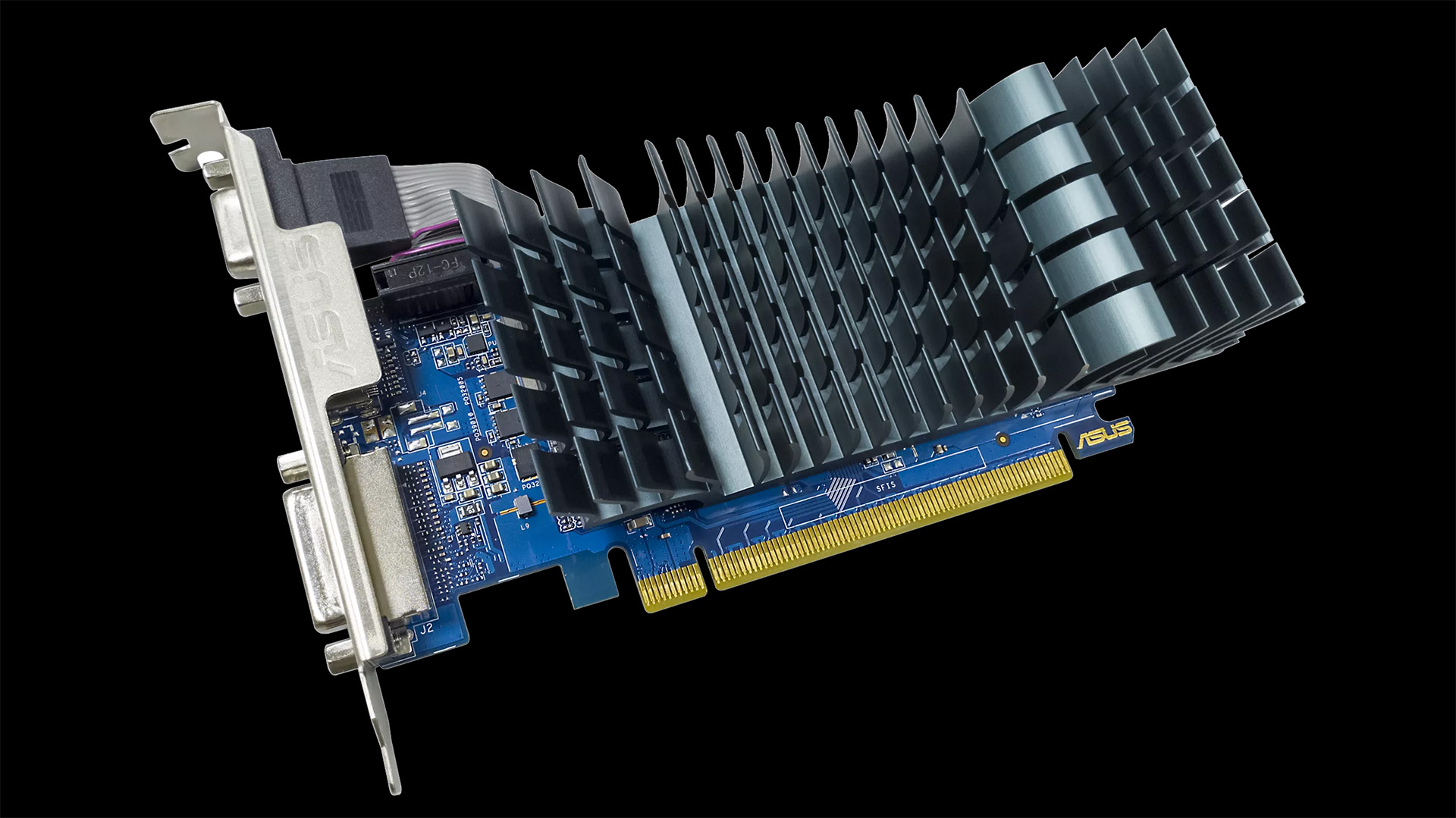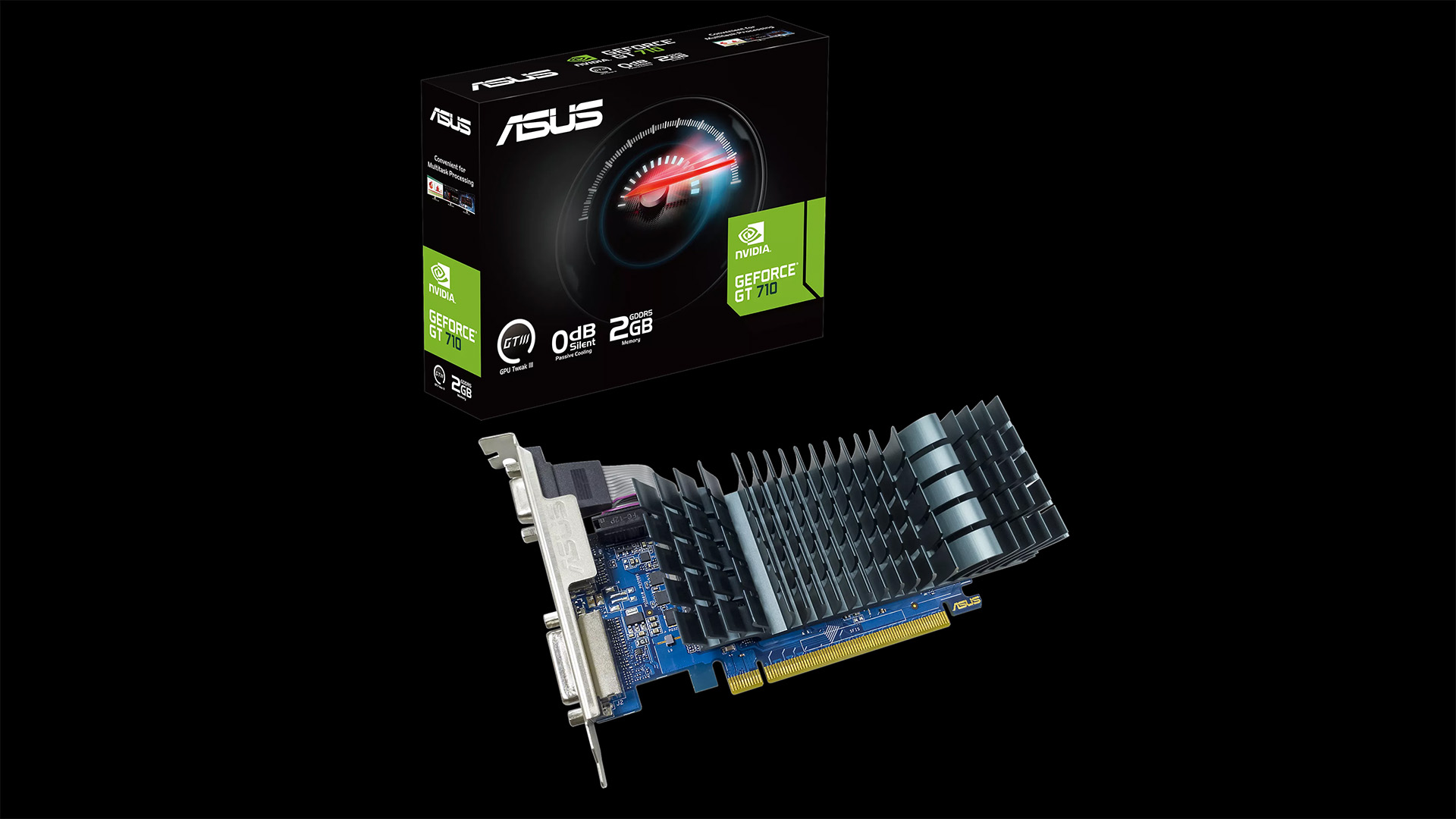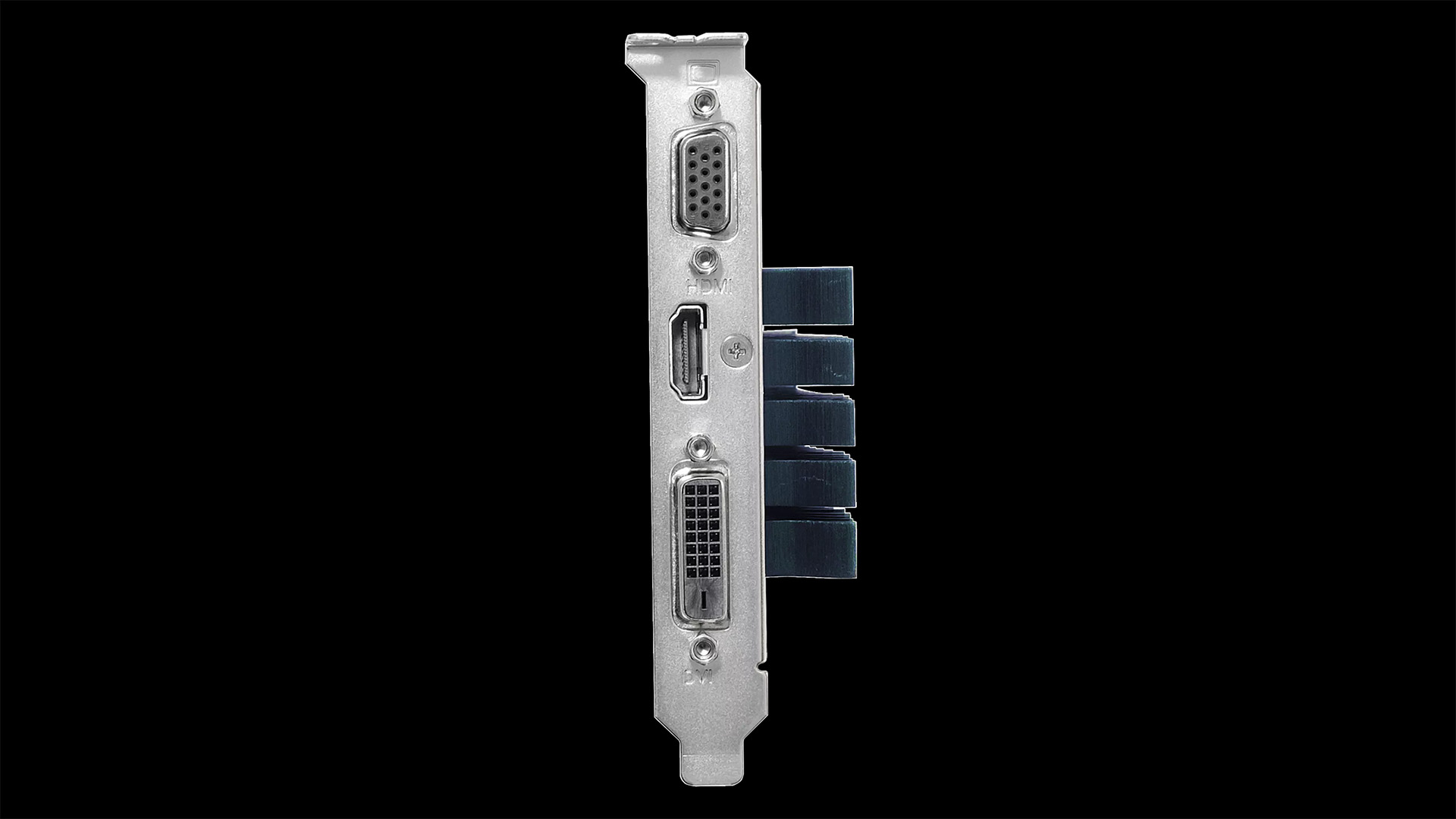10-year-old Nvidia GPU is still receiving love from vendors — Asus debuts GeForce GT 710 EVO with 2GB GDDR5 memory
Asus new GeForce GT 710 EVO comes with a passively cooled heatsink, HDMI, DVI, VGA, and 2GB of GDDR5 memory

Asus is known for making all kinds of graphics cards, from low-profile to some of the best graphics cards. However, the GPU manufacturer has decided to release a new GT 710 graphics card—and it's not a fancy one like its quad-HDMI-port GT 710 from four years ago. The new card, the GT 710 2GB GDDR5 EVO, sports a low-profile design optimized for SFF rigs and HTPCs. Pricing and availability have yet to be announced.
By this point, the Kepler-based GPU was over ten years old and was the slowest Kepler-based product you could buy at release outside of some mobile variants. That said, there are a few reasons we can think of that would incentivize Asus to make another GT 710 variant in 2024.
These older cards are perfect for getting ancient systems up and running with video output, particularly if they won't boot with newer GPUs optimized for newer motherboard UEFI firmware. The GT 710 is also one of the cheapest graphics cards in the world, and you can buy brand-new ones, which is an obvious selling point to anyone on a severe budget for an essential GPU.


Asus' GT 710 EVO is as basic as graphics cards get right now. The card sports a blue-colored low-profile PCB featuring a black heatsink that passively cools the GK108B GPU underneath. The card comes with three VGA, HDMI, and DVI, making it one of the only cards still sold today with the ancient VGA port. However, the VGA port must be disconnected when using a low-profile PCIe bracket on the card.
Specs-wise, the card has just 2GB of GDDR5 memory and a PCIe Gen 2 interface. The GPU sports 192 shader units, eight ROPS, 512KB of L2 cache, a 64-bit memory bus, and a 954 MHz reference clock. Power consumption is one of the GPU's greatest strengths, rated at just under 20W, making it compatible with virtually every planet system with an x16 PCIe slot.
Even after ten years, the GT 710 is still being sold everywhere and is available in multiple SKUs from multiple form factors. Even Nvidia's successors, such as the GT 1010 and GT 1020, have not seen as much success as the GT 710. The only other entry-level Nvidia GT product today that is still widely available is the GT 1030, but that card regularly goes for $100, more than double what the GT 710 is sold at and close to the price of entry-level gaming GPUs.
For one reason or another, the demand for the GT 710 continues to be significant enough for manufacturers to keep pumping out these GPUs, which is why Asus launched the GT 710 EVO.
Get Tom's Hardware's best news and in-depth reviews, straight to your inbox.

Aaron Klotz is a contributing writer for Tom’s Hardware, covering news related to computer hardware such as CPUs, and graphics cards.
-
punkncat What about driver support?Reply
I was of the impression that everything back farther or less powerful than the 750 was no longer supported. -
Alvar "Miles" Udell Replypunkncat said:What about driver support?
I was of the impression that everything back farther or less powerful than the 750 was no longer supported.
It's on the security update track, the latest driver was from February 2024 and supports though Windows 11, the last driver update from a 10 year old AMD card, the R9 200 series, was 2022 and doesn't officially support Windows 11.
I see a GT 710 on Newegg for $40 (a Gigabyte variant). Considering it has Windows 11 support it would make for a great spare card for emergencies, say if your nice expensive RTX card had to be RMA'd. -
Notton "sports a low-profile design optimized for SFF rigs and HTPCs"Reply
I'd argue that it is, in fact, not a good choice for SFF and HTPCs, when it doesn't do AV1 decode, and occupies 2 slots.
Single slot low-profile with AV1 decoding exists in the form of Arc A310 from Sparkle. In fact, it even does AV1 encoding. -
Reply
Asus new GeForce GT 710 EVO comes with a passively cooled heatsink, HDMI, DVI, VGA, and 2GB of GDDR5 memory... the GPU manufacturer has decided to release a new GT 710 graphics card
Are you sure this is a new GPU from ASUS ? ASUS even released a VGA driver for this GPU last year, dated 2023/11/28. I have seen this exact same GPU being sold online at various e-tailers worldwide.
But if you have the link for this new model, please share. The article is not having any link/source.
On their official website, I couldn't find any other model.
Yes x 1 (Native Dual-link DVI-D)
Yes x 1 (D-Sub)
Yes x 1 (Native HDMI 1.4a)
https://www.asus.com/motherboards-components/graphics-cards/asus/gt710-sl-2gd5-brk-evo/helpdesk_download?model2Name=GT710-SL-2GD5-BRK-EVO -
ivan_vy for 0.37 TFLOPs is really necessary this card?Reply
Intel HD Graphics 4600 from Haswell 2013 has 0.3-.043 TFLOPs, AMD A10-6700T (2013) 0.58 TFLOPs.
the case uses for the 710 is very narrow. -
emike09 I used to buy tons of these for work. Easy, cheap way to add additional monitor support. Totally fine for everyone who didn't need a GPU to do GPU things, just more displays. It's sad it's still being manufactured. I'd like to see something like an RTX 3010 or 4010. Especially with AI trickling down to the average consumer, there's benefits for things like RTX Super Resolution and SDR to HDR conversion without the need for gaming power, though chips like these could probably still handle low-end and older title gaming just fine.Reply -
GaPony I'm still using a GTX 750 and GTX 950 GPU in 4th Gen Core-i7 CPU PCs running Win10. I'm not a gamer and these older systems work fine for my needs, which is mostly productivity, running a Plex server, and web browsing. I'm planning an upgrade to Win11 with 11th Gen CPUs, but will likely keep using the GTX 950 for one system and maybe an RTX 3060 for the other, as my visiting grandson does some light online gaming. For more serious games I have an XBox and PS5 for him to use. I refuse to chase the bleeding edge. Been there, done that years ago. It's futile.Reply -
Alvar "Miles" Udell Reply
What about the hundreds of thousands of machines with AMD processors which lack an iGPU, or with Intel F series CPUs which lack a GPU? There's no such thing as a "modern" basic GPU anymore, this fits that bill nicely.ivan_vy said:for 0.37 TFLOPs is really necessary this card?
Intel HD Graphics 4600 from Haswell 2013 has 0.3-.043 TFLOPs, AMD A10-6700T (2013) 0.58 TFLOPs.
the case uses for the 710 is very narrow. -
CmdrShepard Reply
What does the amount of TFLOPS have to do with anything? Nobody is buying this card for compute.ivan_vy said:for 0.37 TFLOPs is really necessary this card?
Intel HD Graphics 4600 from Haswell 2013 has 0.3-.043 TFLOPs, AMD A10-6700T (2013) 0.58 TFLOPs.
the case uses for the 710 is very narrow.
That's what I was saying in the other thread but people tried to prove me wrong by showing some entry level cards. Thing is, all of those new cards are still behemoths compared to stuff like this and the reason is simple -- there are no entry level chips. It's the same huge monolitihic die (at least for NVIDIA) which is in the top end cards with some units fused off, most likely because they weren't working anyway.Alvar Miles Udell said:There's no such thing as a "modern" basic GPU anymore, this fits that bill nicely. -
ivan_vy Reply
for an extra monitor output makes sense, for tinkering and troubleshooting an USB options would be more versatile, I guess the drivers would be an issue.Alvar Miles Udell said:What about the hundreds of thousands of machines with AMD processors which lack an iGPU, or with Intel F series CPUs which lack a GPU? There's no such thing as a "modern" basic GPU anymore, this fits that bill nicely.